#schrammelmusik
Photo

The famous Schrammel quartet in 1890
Schrammelmusik ( German pronunciation: [ˈʃʁaməlmuˌzik] ) is a style of vienese folk music originating in the late nineteenth century and still performed in present-day Austria. The style is named for the prolific folk composers Johann and Josef Schrammel.
1 note
·
View note
Photo

Wenn die Schrammeln aufspielen #16erbuam #schrammeln #wean #schrammelmusik #wienermusik #wienblues #akkordeon #gitarre #live #garten #heuriger #heurigenmusik #dornröschenkeller #musik #wienbleibtwien #wienliebe #stammersdorf #kellergasse #wien #vienna #igersvienna (hier: Stammersdorfer Kellergasse) https://www.instagram.com/p/CRyRnPGFoFv/?utm_medium=tumblr
#16erbuam#schrammeln#wean#schrammelmusik#wienermusik#wienblues#akkordeon#gitarre#live#garten#heuriger#heurigenmusik#dornröschenkeller#musik#wienbleibtwien#wienliebe#stammersdorf#kellergasse#wien#vienna#igersvienna
0 notes
Text
Teine nädal (28.09-4.10)
Postituse jagan kaheks: ülevaade sellest, mida teinud olen ja teiseks suvalised tähelepanekud Viini elu kohta.
Teine nädal möödus sotsialiseerumise tähe all. Käisin kahte sorti üritustel: need, mida korraldas Erasmus Student Network (ESN) ja juurakate oma üritustel. Viinis on mul vedanud, et juuratudengid tegid ühise Whatsappi grupi ja leppisime kohe kokku kohtumise, mida eelmises postituses mainisin. Juba esimesel kohtumisel jäi mulje, et tegemist on huvitavate ja mõistlike inimestega ja edasised kohtumised on seda ainult kinnitanud. Nüüdseks on meist kujunenud umbes 15-20 inimesega sõprusgrupp, kellega on huvitav rääkida nii juurast kui ka muidu mõnusalt aega veeta. Natuke huvitavat statistikat ka: tuleb välja, et enamus meist on 23 ja enamik meist on juuraõpingute viimasel aastal. See on mulle suureks kergenduseks, kuna Erasmuse programmil üldiselt on tugev noorte pidutsejate maine, mille jaoks ma tunnen, et hakkan juba veidi vanaks jääma. :D
28.09
Aga alustan sealt, kus eelmisel korral pooleli jäi. Päev peale esimest üritust ja toidufestivalil käimist osalesin järgmisel päeval ESN-i Photo Challenges üritusel, mis hõlmas väikeste gruppidega (vana)linna peal erinevate kohtade otsimist ja seal piinlik-naljakate ülesannete täitmist ja nende pildistamist. Sellest suurt rohkem rääkida pole, põnevam on ülejäänud päev, kui kõigepealt käisin juurakatega esimest korda ehtsas Viini kohvikus: Kaffee Alt Wien. Autentne ajalooline kohvik, kus viisakalt riietatud (mees)kelner kliente teenindab. Esimest korda proovisin ka viinipärast kohvi melange, mis ausalt öelda maitseb nagu tavaline cappuccino. Väga meeldib, et Viinis tuuakse kohvi kõrvale alati tasuta klaas vett!
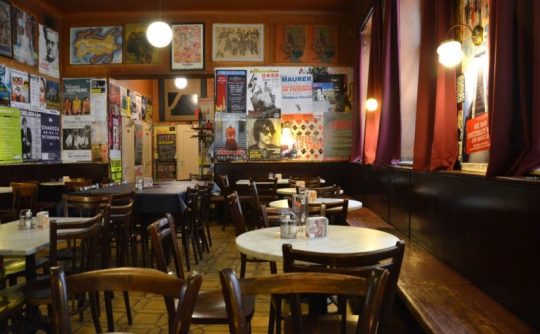
Sealt edasi liikusime paari teise juurakaga hoopis Itaalia restorani, nimeks Via Toledo. Kogemuse tegi meeldejäävaks see, et seltskonnas olid enamik inimesi pärit Itaaliast või vähemalt selle lähedalt. Eriti naljakas oli, kui jutt läks rahvusliku toidukultuuri juurde ja mult küsiti, mis on eestipärane söök ja ega ma muud huvitavat ei osanudki öelda, kui et suht sama, mis Saksamaal - ikka liha ja kartulid. Moka otsast vist poetasin, et kala sööme ka. Samal ajal kõrval šveitslane selgitas, milline on ikka õige fondüü ja kust Viinis korralikku gruyère juustu saab. Via Toledos aga saab tõesti head pitsat ja seda kinnitasid isegi itaallased. Väidetavalt on tegu lausa Austria parima ja Euroopa teise koha auhinna saanud pitsarestoraniga.

29.09
Kuna eelmisel päeval veetsime kohvikus vaid põgusalt aega, võtsin suuna taas ühe Viini kohviku poole, seekordseks valikuks osutus Cafe Jelinek - taaskord üks kena traditsiooniline Viini kohvik.
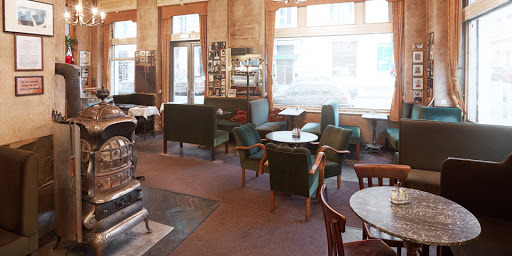
Õhtul läksin ESN-i korraldatud keelekohviku üritusele, mille sisuna ma lihtsalt oma tuttavate ja vähem tuttavate juurakatega paar tundi saksa keeles juttu puhusin. Nüüdseks olen keeleoskusega jõudnud sinnapaika, kus grammatika ja õigesti rääkimine teeb vähem muret ja kõige suuremaks probleemiks on väike sõnavara, eelkõige igapäevased sõnad. Üritus toimus kohas nimega Cafe Votiv.
Sealt edasi liikusin juba tuttavate juurakatega ühte tudengite seas populaarsesse iiri pubisse Dick Mack’s. Nüüdseks on mulle selgeks saanud, et see koht mulle üldse ei meeldi ja ausalt öeldes ma ei mõista, miks inimesed niivõrd imelises linnas nagu Viin, kus on sadu huvitavaid kohti, ikka geneerilisse iiri pubisse tikuvad. Ega hinnadki nii palju kohtade lõikes ei erine.... 0.5l õlut maksab igal pool keskmiselt 4€. Aga vähemalt üks meeleolukas pilt:
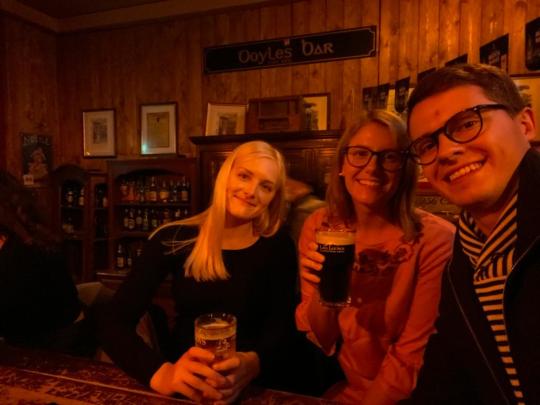
30.09
Vot see oli üks taoline päev, mille nimel ma Viini tulingi. Nimelt on Viini lähedal arvukalt veiiniistandusi, kus asuvad heuriged. Vikipeedia võtab asja kontseptsiooni hästi kokku:
In eastern Austria, a heuriger is a tavern where local winemakers serve their new wine under a special licence in alternate months during the growing season. The Heurige are renowned for their atmosphere of Gemütlichkeit shared among a throng enjoying young wine, simple food, and - in some places - Schrammelmusik.
Ehk võtsime juurakatega suuna linnapiiri suunas, et metroopeatusest veidi edasi künka otsa kõndida ja mõnes heuriges kohalikku veini mekkida. Veetsime seal paar meeleolukat tundi. Künka otsast oli kena vaade, seltskond suurepärane ja vein... ka okei - mida veel elult tahta?


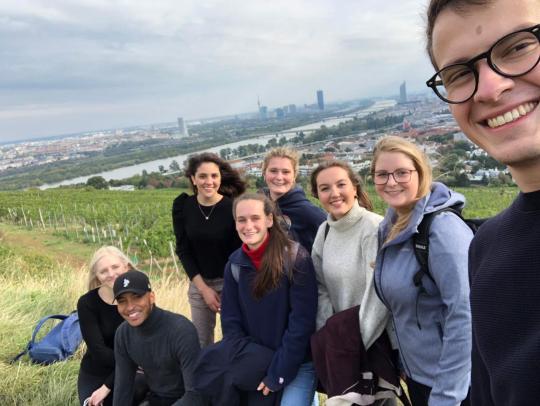
Peale veinitrippi läksime tagasi linna ja kuna olime juba pärastlõunal veinijoomisega algust teinud, tundus paslikum samaga jätkata. Peale väikest kebabipausi läksime tagasi Dick Mack’s pubisse ja olime seal õhtu lõpuni. Õhtust mäletan kõige eredamalt seda, kuidas üks šveitslane mulle väga kirglikult seletas, kuidas Euroopa Liit on ebademokraatlik ja küllaltki autoritaarne institutsioon (kuivõrd Šveitsis ju otsedemokraatia suure au sees on). Peale mõningast diskussiooni oli ta siiski nõus möönma, et Balti riikide jaoks toob EL rohkem kasu kui kahju.
01.10
Neljapäeval ma ühelgi ESN-i üritusel ei käinud, aga kuna eelmisel päeval värskes õhus veedetud aeg mulle nii sügava mulje jättis, otsustasin ise ka väikest viisi matka ette võtta ja mõne kohaliku künka otsa ronida. Viini on olemas linnasisesed matkarajad, koondnimetusega Stadtwanderweg. Igal matkarajal on oma number ja kokku on neid kümne kanti. Mina võtsin eesmärgiks läbida Stadtwanderweg 4a. Kuna ma polnud väga hästi kursis, kuidas selle raja jälgimine käib (vahel märkasin vaid puudel ähmaseid teed juhatavaud värvitriipe), siis tegin omajagu kõrvalekaldeid, aga lõpuks jõudsin taas ühe väikse mäetipu otsa. Kuna matk tuli ühtekokku üle 10km ja esimeses pooles üsna järsu tõusuga, siis olin ma lõpuks koju jõudes küllalt väsinud ega rohkem suurt midagi ette ei võtnudki.
02.10
Kasutasin ära enda kunstimuuseumi aastakaarti ja käisin pärastlõunal taas ühte näitust vaatamas. Seekord oli tegemist Beethovenile (Beethoven bewegt) pühendatud näitusega - heliloojal on sel aastal 250. juubel. Näha sai nii Beethoveni käsikirjas noote, tema kuuldetoru ja tema testamenti, mida oli ausalt öeldes üsna kurb lugeda. Aga samas oli seal ka teoseid nt Turnerilt, Friedrichilt, Goyalt ja Berninilt, seega igati mitmekesine värk.
Õhtupoole võtsin suuna Praterile. Kasutan taas Vikipeedia abi:
Prater on avalik park Viinis Leopoldstadtis. Pargis asub lõbustuspark Wurstelprater, mida tihti ka lihtsalt Prateriks kutsutakse. Park on kõigile külastajatele avatud alates 1766. aastast. 1873. aastal toimus seal maailmanäitus.
Sain juurakatega kokku lõbustuspargi külje all asuvas traditsioonilises Biergartenis Schweizerhaus. Tegemist oli ilmatu suure asutusega, millel oli aga lahe kohalik atmosfäär. Enamik külastajatest tundusid kohalikud (kuigi nagu varem öeldud, turiste paistab siin praegu üldse vähe olevat).

Spontaanselt liikusime Schweizerhausist edasi Prateri lõbustusparki, kus isegi sellise karuselliga tiiru tegin:

Kuna see tõusis üsna kõrgele, pelgasin sõitu alguses korralikult. Aga kui paar spritzerit on juba keres, tunduvad paljud asjad mõistlikumad, kui nad muidu tunduksid.
Õhtut jätkasime traditsioonilise Viini meelelahutusega ja läksima Doonau kanali äärde istuma.

Kui liiga külmaks läks, liikusime edasi ühte lähedalolevasse pubisse Pickwick’s, mis õnneks oli siiski veidi mõnusama atmosfääriga kui Dick Mack’s.
03.10
Päeva esimeseks märkimisväärseks sündmuseks oli ESN-i korraldatud jalutuskäik Viini Zentralfriedhofis ehk surnuaias. Tundub ehk veider, aga tegemist on ühe Viini olulise vaatamisväärsusega. Ja surnuaed on tõesti suur: 2.5 ruutkilomeetrit ja vähemalt 3 miljonit kadunukest. Täpselt selline koht, kus võiks mõnda õudukat filmida:

Pärast surnuaia külastust liikusin edasi siiani viimasele ESN-i üritusele, mis toimus Stadparkis. Veetsime seal paar tundi, aga tegelikult ootasin juba ülejäänud õhtut. Olin teistele juurakatele ette pannud, et lähme minu kodukanti ehk Neubaud ehk 7. Bezirki avastama, sest siin on palju omapäraseid baare/pubisid/kohvikuid. Pargist lahkudes aga järgnes meie seltskonnale veel 15 suvalist Erasmuse tudengit, mis tekitas minule kui “grupijuhile” aga paraja peavalu, sest 1. laupäeva õhtul on keeruline leida üheski kohas istekohta 20+ inimesele ja 2. koroona tõttu tohib Viinis praegu ühes lauas istuda max 10 inimest. Igatahes ajasime Neubausse jõudes kontvõõrad viisakalt minema ja istusime oma tuttavatega maha kohas nimega Ulrich.
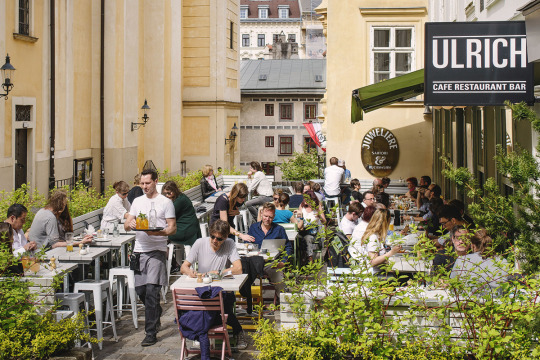
Kui nälg hakkas näpistama, kõndisime minu kodu lähedal kuulsasse kebabikohta Berliner Döner, kus ma tegin ohtliku avastuse, et igati maitsev falafel sandwich maksab ainult 3€. Kahtlustan, et hakkan seal rohkem käima...

Sealt liikusime edasi (mitte minu valikul!) järjekordsesse iiri pubisse nimega The Lizzard, mis muidu polnudki nii kohutav, aga sai koleda lõpu, kui meie olime viimased baari jäänud inimesed ja selgus, et muud Erasmuse matsid (kelle me esialgu olime enda seltskonnast minema ajanud) jätsid maksmata 25€ arve, mille jaoks meie pidime rahad kokku panema. Igatahes on The Lizzard minu blacklistis ja meelsamini korraldan üritusi vaid juurakatega vm inimestega, keda ma päriselt tean.
04.10
Suure plaanina pidime sõpradega minema taaskord matkama ja mõnda heuriget külastama, aga plaanile tõmbas kohe hommikul vee peale see, kui üks noormes meie seltskonnast teatas, et tal on külmetuse sümptomid ja et ta sõbral on koroona. Jätsime muidugi ürituse ära. Ootame siiani ta testi tulemusi, aga igatahes võib öelda, et ülejäänud päev möödus mustemas meeleolus. Kahju, sest ilm oli superilus - päikseline ja 20+ kraadi. Jalutasin omaette linnas ringi ja istusin lõpuks Prateris maha ja lugesin pargis raamatut.
05.10
Täna midagi märkimisväärset toimunud pole, olen vähese eduga üritanud oma magistritöö kallal nokitseda ja õhtupoole käisin Schönbrunnis jalutamas.
Suvalised märkused kohaliku elu kohta:
1. Toidupoed jms kaubandus - esimese negatiivse asjana võin märkida, et enamikus toidupoodides (eelkõige siiski odavamates) on ikka üsna kehv valik. Põhilised asjad on olemas, aga heal juhul 1-2 sorti, Eestiga võrrelda ei anna. Teise asjana, mis mind isiklikult närvi ajab, on poodide lahtiolekuajad: nädalapäevadel pannakse kõik (toidu)poed kl 20 kinni, laupäeval kl 18 ja pühapäeval ei tee nad üldse uksi lahti. See küll ei tähenda, et keegi pühapäeval nälga jääks - restoranid, kohvikud jne on lahti -, kuid üleüldine šoppamine võimalik ei ole ja seaduse järgi tohib linnas lahti olla vaid paar üksikut poodi.
2. Kohalikud valimised - pühapäeval toimuvad Viinis kohalikud valimised ja seetõttu on terve linn valimisplakateid täis. Teoreetiliselt saaksin mina ka siin valida, aga selleks oleksin pidanud oma peamise elukoha juba juulis Viini registreerima. Ühe eredama näitena tooksin välja Bierpartei ehk õllepartei valimisplakatid:


3. Tipi andmise kultuur - siin peaks teoorias suht igal poolt tippi jätma sh nt baarist jooki ostes. Küll aga ei ole siin viisakas jätta tippi laua peale nagu Eestis, vaid öelda teenindajale kohe, kui palju maksta tahad. Nt kui arve on 8.50€, siis ütled, et palun 9€. Järjekordne asi, mis omajagu harjumist vajab.
4. Sularaha, igal pool - paljudes kohvikutes ja baarides sh kesklinnas (sic!) saab maksta ainult ja ainult sularahas, mis on jällegi omajagu tüütu. Poodides saab õnneks pangakaarti viibata, aga kuuldavasti oli olukord paar aastat tagasi veel hullemgi.
5. Spordikursused - ülikooli spordiinstituut pakub odava hinnaga spordikursusi, mina valisin endale ühe trenni - HIIT-Tabata, mis minu Eesti kogemuse järgi kujutab endast intervallide kaupa intensiivset liigutamist.
6. Ülikooli bürokraatia - eelkõige ainetele registreerimine. Siin on küll olemas ÕIS-i taoline süsteem, kus ennast ainetele registreerida saab, aga kuidagi pole võimalik enne ainele registreerimise lõppu teada saada, kas oled üldse kursusel koha saanud. Ja selleks ajaks, kui teada saad, et võibolla pole ainesse kohta saanud, on jällegi teistele ainetele registreerimine kinni. See toidab süsteemi, kus tudengid kõikvõimalikele ainetele lihtsalt igaks juhuks registreerivad ja ainete registreerimisnimekirjad täituvad kiirelt ja sageli inimestega, kes ei pruugi tahtagi ainel tegelikult osaleda. Semester käib juba 1. oktoobrist alates, aga mina olen siiani ametlikult registreeritud vaid kolmele ainele. Absurd, ma ütlen!
Sel nädalal algavad mul ka esimesed ained, loodame, et mu sõbral ja omakorda mul koroonat ei ole ja saan õppetööd karantiinita alustada!
1 note
·
View note
Text
Exs24 Vst Plugin

Exs24 Vst Plugin Torrent
Exs24 Vst Plugin Download
Exs24 Vst Plugin Software

http://syntheway.com/Akkordica.htm - Virtual Harmonica preset demo included in Akkordica v1.0 VST Plugin. VST for PC Windows, and Audio Unit + VST for macOS and Mac OS X. See requirements below.Software Description: Akkordica is a Virtual Accordion, Harmonica and Melodica software that covers a wide range of sounds, by combining the traditional accordion performance and modern digital functionality. Suitable for a wide range of musical styles, be it traditional, popular or classical.Akkordica VST Features:- Mode Selector to change between the following instruments:1.- Piano Accordion2.- Anglo Concertina3.- Strasser Accordion4.- Hohner Accordion5.- Musette Accordion6.- Harmonica Natural7.- Harmonica Vibrato8.- Melodica (Pianica)9.- Accordina (Harmonicon)- Akkordica allows you to reproduce many different accordion types (diatonic and chromatic) for various genres of musical styles such as Folk, Rock, Blues, Jazz, Polka, Tango, Bal-musette, Cajun, Zydeco, Classical, Schrammelmusik, Klezmer, Levenslied, Sevdalinka, Boeremusiek, Forró, Merengue, Cueca, Milonga, Chamamé, Cumbia, Vallenato, Norteño, Tex-Mex, Saltarello, Tarantella, Ceol, Basque Trikitixa and Inuit music.- The harmonica (known as a French harp or mouth organ) comes with two modes: natural and vibrato, to be used in many musical genres, notably in blues, American folk music, classical music, jazz, country, and rock and roll. - 32 Presets. Additionally, players can create different acoustic and electronic sounds.- Multimode Filter. The use of values automatically computed by a multimode filter gives a wide range of interesting tones. Filter switch includes: LP (Low pass), HP (High pass), BP1 CSG (Band pass 1, constant skirt gain), BP2 C0PG (Band pass 2, constant 0db peak gain), Notch (Band-stop/Band-rejection) filters with adjustable Resonance and Cutoff Frequency range extends up to Nyquist. Gain Compensation option for LP, HP and BP1 filter types.- ADSR envelope generator. Attack, Sustain, Decay and Release parameters and several modulation targets.- LFO (Low Frequency Oscillator) with modulation depth, frequency and offset. This creates a kind of a “trembling” sound for squeezebox instruments, harmonica and melodica.- FULL MIDI Automation: Complete MIDI Continuous Controller. You can use this to automate parameter changes from a sequencer, or to control your synthesizers from an external MIDI control surface. The name Akkordica is a portmanteau of the German word 'Akkordeon' (Accordion) and 'Melodica'.
Exs24 Vst Plugin Torrent
Genre
Jazz & Blues
Exs24 Vst Plugin Download
EXS24 (Apple) POWERFUL LOGIC PRO X STOCK PLUGIN WITH DEEP CONTROLS AND LOADS OF PRESETS. Logic Pro X users rejoice! EXS24, Apple’s stock sampler, is a powerful bit of kit that can compete with many third party options. Open it up and you’ll be presented with six filter options, three LFOs and a comprehensive modulation matrix. Inspector parker game free.
Logic EXS24 mkII. Logic’s built in sampler plugin is the powerful EXS24, now on version mkII. EXS24 is another capable modern sampler well suited to loading hyperrealistic multi-GB sample libraries of orchestral instruments. EXS24 it’s equally at home on loops, phrases and single samples. Best Free Sampler VST Plugins. Instructions: Click each link below and look around each website for the download link or button. Jw library app. Do not install any suspicious software. TX16Wx VST – Windows / Mac.
Exs24 Vst Plugin Software
VST for PC Windows, and Audio Unit + VST for macOS and Mac OS X. See requirements below.Software Description: Akkordica is a Virtual Accordion, Harmonica and Melodica software that covers a wide range of sounds, by combining the traditional accordion performance and modern digital functionality. Audio plugins,Free plugins for Logic Pro X,Free music software,free audio app and free plug-in downloads,free VST/AU plugins for your PC or Mac,32/64-bit, Freeware.
0 notes
Text
raquette de tennis solde
dans le courant de 1970, Dave Raquettes De Padel Moins Cher Godin, de blues et de l'âme Journaliste et London Soul City le propriétaire d'une boutique, a visité le club et surnommée la musique qu'il a entendue northern soul.Seeing que la façon dont nous avons été traités à une libération AJXI autour de ce temps pour les quelques dernières années, nous sommes juste de simples semaines de l'arrivée de cette marque nouvelle couleur scheme.His a été fait dans le style cependant que Johnson a dévoilé son asics 2160 'Université de l'Arizona' baskets personnalisées pour révéler sa décision. Quand il vient à des célébrités, il ne vient pas vraiment une surprise quand ils montrent une partie de leurs nouvelles acquisitions un peu plus tôt que ce qu'ils sont censés release.2013 OG releaseFollowing re-le à partir de l.Likely de vendre dans un battement de coeur, recherchez le Daniel asics gel beyond mt 'Doernbecher' pour libérer aujourd'hui en quantités limitées à un.
In empruntant le argyle print infâme de chandails de Cliff, tous vous sneakerheads aura quatre modèles de diamants différents choix from.tirant ces vêtements plus lourds à partir de notre salle d'échantillons plus tôt cette semaine nous a fait un peu de nostalgie pour les mois les plus froids de revenir autour (non pas que nous avons eu de nombreux mois plus chauds cette année.Last nuit l'artiste monta sur scène avec une paire 'Oreos' pour effectuer une partie de sa récente grande hits. Kazuki à bord pour certaines collections spéciales. Ayant déjà abordé pas mal de silhouettes classiques Asics et Chaussures Vente En Ligne.Having partageaient déjà un bon nombre de regards à cette version à venir très attendu, il semble que nous avons quelques images officielles pour transmettre des asics gel femme soldes.
Nous rejoindre le Tennis Vente En Ligne trajet que l'autobus commence à faire ses rondes.Adding à l'attrait visuel des chaussures est l'ajout du logo Asics sur le stat-couvert bottom.Landing chez les concessionnaires britanniques maintenant, restez à l'écoute de fichiers Sneaker pour mot sur une version stateside pour Le asics femme 2016 Mid GS 'Metallic Gris foncé / Metallic Gold-Cour Violet'. Comme l'arôme de saucisses et de moutarde fusionné avec ies de beugler accordéons pomper de leurs nombreuses Schrammelmusik soupapes, j'ai été obligé de saisir la proximité d'une présidence d'empêcher Bauhaus moi-même de s'effondrer.Ewing Athlétisme prit forme immédiatement avec leur premier modèle, l'effet de rebond, et puis de nouveau avec la désormais légendaire 33. Surnommé 'OKC' pour sa relation avec les couleurs de l'équipe Thunder d'Oklahoma City, cet asics gel trabuco 13 S'affiche un motif de camouflage distinct au sommet de sa Hyperfuse supérieure dans un royal officiel du jeu, blanc, équipe orange, et bleu universitaire.
www.sportsoldes.com/padel/chaussures

0 notes
Photo

Wellen: German Federated Pop and New Wave
Fifth mix in my survey of European pop music in the early-to-mid 1980s. What you’ve missed if this is new to you:
Spain & Portugal | France | Italy & Greece | Northern Europe
This time around it’s Germany, and Austria and Germanic Switzerland. Here’s the tracklist, notes are below the line.
Joachim Witt, “Goldener Reiter”
Lilli Berlin, “Ostberlin—Wahnsinn”
Babsi Balou, “Hochsaison im Eissalon”
Hubert Kah, “Engel 07″
Carmen, “Es ist kalt um mich herum”
Grauzone, “Eisbär”
Trio, “Bum Bum”
Peter Schilling, “Terra Titanic”
Minisex, “Rudi, gib acht”
Spider Murphy Gang, “Wo bist du?”
Nina Hagen, “Zarah (Ich weiß, es wird einmal ein Wunder geschehn)”
Der Plan, “Gummitwist”
Cosa Rosa, “Millionenmal”
Contact, “Schwarze Madonna”
Neonbabies, “Horizonte ohne Ende”
Collage, “Mit den Puppen tanzen”
mittageisen, “Automaten”
Nena, “Irgendwie, irgendwo, irgendwann”
Rheingold, “Via satellit”
Falco, “Junge Roemer”
Xmal Deutschland, “Feurwerk (31-Dez)”
Wellen: german federated pop and new wave
This is the fifth mix in this series, and the first time since the mix that started it all that there’s an actual scene to document. Which isn’t to suggest that new wave (and punk) didn’t affect French, Italian, and Scandinavian music of the 1980s, but that new wave in those countries didn’t cohere into a self-sustaining cultural space; rather, it fractured, either assimilating into the light entertainment traditions of those various nations, or remaining defiantly underground and rarely succumbing to such sellout moves as TV appearances or chart success.
But in Germany, as in Spain, the Neue Deutsche Welle (new German wave) saw electronic experimentation combined with punk energy (and, just as important, punk silliness) and the whole mess achieving mainstream velocity. As with the Spanish Movidas, it’s a matter of dispute how long the actual scene lasted before burning out and either being co-opted by the mainstream or transforming the mainstream enough to be indistinguishable from it. My goal with these mixes has been to skim over the initial, well-documented burst of energy which lasted from 1978 to 1981, focusing instead on the later period of assimilation (or maturation, or disintegration, as you prefer) from 1982-1986, which tends to be the province of nostalgists rather than mythmakers.
It’s worth taking stock of German music, and Germany as a whole, in the early 80s. (All the music in this mix is in German, with occasional mid-song interruptions in other languages, but four songs are from Austria and two from Switzerland, both of whom remained neutral in the Cold War; the majority are from West Germany. East Germany had its own scene, and will be heard from in a subsequent mix.) Unlike Britain, Spain, or France, Germany was not a unified nation-state which dated back to the late Middle Ages; only since the mid-19th century had (some of) the modern German-speaking peoples been united into a single nation. When the Allies divided Germany again during the Cold War, leaving the traditional seat of power, Berlin, stranded in the East, with the tiny island of West Berlin surrounded by Communist red on every map, West Germany was necessarily decentralized: Hamburg, Düsseldorf, Hanover, Munich, and Stuttgart were among the many cities which took the industrial and cultural initiative without waiting for any central policy. The resulting Wirtschaftswunder, or economic miracle, of the 1950s and 60s, in which a bombed-out West Germany came roaring back to life thanks to judicious economic policies and heavy investment laid the stage for the social upheavals which swept Western Europe in the late 60s. Germany, as music nerds know, was an epicenter for radical, experimental and progressive cultural movements from Stockhausen to kosmische: in a sense, the Neue Deutsche Welle was merely transplanting the radical experiments of the previous decade into the pop sphere.
And it was so much in the pop sphere that some of it even crossed the Atlantic — this may be the mix heaviest on names the average US listener who knows a bit about 80s pop will recognize. Trio (“Da Da Da”), Nena (“99 Luftballons”), Falco (“Amadeus”), Peter Schilling (“Major Tom”), and perhaps Nina Hagen (“Smack Jack”) and Hubert Kah (“Angel 07”) are all more or less recognizable names in the Anglosphere, if unfairly tagged with one-hit wonder status here. (Why German, and not say French or Italian, pop music found a friendly home on Anglophone airwaves remains an underdiscussed phenomenon to this day.) But even beyond flashback radio listeners, few of my picks will be surprising to anyone who’s spent time with any the dozens of stellar Neue Deutsche Welle compilations that have been issued over the years: I tend to lean more toward pop than punk, toward funk than motorik, but I don’t expect to be blowing any minds which have focused in this direction before.
I did want to note that the title of this mix, while it’s merely an obvious pluralization of the Welle in Neue Deutsche Welle, meant to reflect the diversity of regional and national scenes represented, is also a reference to one of my favorite books I’ve read this year: the 1911 novel Wellen (called Tides in a 1929 translation, long out of print but available by interlibrary loan) by Baltic German aristocrat and novelist Eduard von Keyserling. This mix, largely about the political and interpersonal concerns of the neon 1980s, may not have much to do with Keyserling’s fragile, constricted fin-de-siècle patricians, except inasmuch as wave after wave always rises and recedes. So we beat on.
1. Joachim Witt Goldener Reiter
WEA | Hamburg, 1981
Perhaps the most important figure in Neue Deutsche Welle who never crossed over to English-language awareness, Joachim Witt was a particularly German (even perhaps particularly Hamburgian) kind of pop star: nerdy, awkward, and existential, with propulsive motorik rhythms and defiantly unheroic guitars. “Goldener Reiter” (Golden Rider), which takes high-traffic roundabouts as a starting point for an urbanized psychological alienation that Kafka and Grosz would recognize, introduced Witt to German pop audiences as a sort of Hanseatic David Byrne: but if this is his “Psycho Killer,” his subsequent career is equally worth hearing.
2. Lilli Berlin Ostberlin—Wahnsinn
Rocktopus | Berlin, 1982
West Berlin was so much in the center of West Germany’s pop scene that all my representatives from Berlin in this mix include female pop stars: but Lilli Berlin harkens back as well to the older Berlin tradition of kabarett: social satire as popular music. A band named for its frontwoman Uschi Lina’s stage name, their only hit of any size was this (“East Berlin—Madness”), in which Lilli and her bandmates trade off shouting “Wahnsinn” in between an idealistic-then-jaundiced travelogue of the city beyond Checkpoint Charlie. The mockery is as much of the right-wing Western establishment’s horror at socialism as of the failed egalitarianism of the East.
3. Babsi Balou Hochsaison im Eissalon
Lemon | Vienna, 1983
But for pure bubblegum pop, we go to Austria. The only single, and that under a stage name, by singer Sabine Chalupa, whose career has mostly been spent singing background vocals, it was a local hit as much for its pre-pubescent innocence (the title is “High Season in the Ice Cream Parlor,” and the verses list all the good summer gelato flavors) as for the specifically Viennese nods toward traditional schrammelmusik (the post-chorus mandolin glosses) and the schoolgirl Italian. “Va bene” when you’re eating ice cream, indeed.
4. Hubert Kah Engel 07
Blow Up | Reutlingen, 1984
Also-rans who relied on flamboyant stage dress in the early Neue Welle, the trio Hubert Kah, named for their charismatic and neurotic frontman Hubert Kemmler, suddenly became one of the biggest bands in Central Europe when they hooked up with Romanian-born superproducer Michael Cretu. The single “Engel 07” (quickly Anglicized to “Angel 07,” but it didn’t do the same numbers in English) was massive, and deservedly so: the moody tale of a man whose one-night stand turns out to be an angel performing heavenly espionage, couched in a low-impact synthworld, is one of the great German pop records of the 1980s. After the crossovers failed to take, Kemmler would have a nervous breakdown and withdraw from music, but he’s since returned, post-depression, and is beloved on the oldies circuit.
5. Carmen Es ist kalt um mich herum
Schallmauer | Essen, 1982
Bedroom pop was not invented in the internet age, although it was arguably perfected there. Carmen Gaspar was one of the rotating cast of backup singers in the ironic NDW lounge act Die Doraus und die Marianas fronted by teenager Andreas Dorau; her solitary solo record, incorporating both electropop and mitteleuropean tradition, was produced and co-written with kabarettist and leftfield pop geek Piet Klocke from Bremen. If the result is pleasantly amateurish in a way that has affinities with later twee pop, it’s also particularly German: Carmen intones about how cold it is around her and her inability to love while the synthesizers plunk and the squeezeboxes squeeze.
6. Grauzone Eisbär
Off Course | Zurich, 1981
Back in the French mix, I noted that Stephan Eicher had first come to prominence leading Grauzone. That was an error, or an incomplete truth. This, Grauzone’s first single and perhaps the Swiss new wave’s finest moment, was written and primarily performed by his brother Martin Eicher; Stephan didn’t join the project until later in 1981. The whole song, from the radio-frequency opening to the metal-on-metal guitar riffs to the skronky sax fadeout, is great enough instrumentally: but Eicher’s shouted lyrics about wanting to be a polar bear at the pole, where it’s so cold he can’t feel sad anymore, makes it one of the all-time great songs about depression.
7. Trio Bum Bum
Mercury | Großenkneten, 1983
The most unlikely pop stars of the most unlikely pop era, the three small-town performance artists turned minimalist punks (drums-guitar-voice) of Trio had scored a worldwide hit with the Casio-assisted “Da Da Da” the previous year; on this followup, producer Klaus Voorman adds subtle bass heft, so that guitarist Gert Krawinkel’s surprisingly heavy guitar lines sound even more like Led Zeppelin. But drummer Peter Behrens maintains an uninflected stomp throughout, and Stephan Remmler’s muttered lyrics about being horny and scoring drugs are the opposite of rock & roll heroism. They liked to call themselves the Neue Deutsche Fröhlichkeit, or New German Cheerfulness: and their method of detourning pop is one of the cheeriest sounds of the decade.
8. Peter Schilling Terra Titanic
WEA | Stuttgart, 1984
Globally famous for “Major Tom,” his shot-for-shot remake of “Space Oddity,” Peter Schilling was only the most prominent Bowiephile in Germanic pop: we’ll see more Thin White Duke borrowings on this mix. His next single, “Terra Titanic,” takes the famous sinking ship as a metaphor for a world barrelling full steam ahead towards climatological and nuclear disaster. Like “Engel 07,” “Bum Bum,” and other songs on this mix, it was also produced in an English-language version, but it wasn’t a hit outside Germany, where dour existentialism married to swelling Romantic melodies has long had a home.
9. Minisex Rudi, gib acht
Schalter | Vienna, 1984
A year after “Every Breath You Take,” the Austrian band Minisex also had a hit about a stalker, but where the British band were all tension and perverse seduction, “Rudi, gib acht” (Rudi, Take Care) positively sparkles with bonhomie, as if the band is assuring one another that they’ve got each other’s back despite this setback. (Both the lead singer’s and the lead guitarist’s first name is Rudi.) Although Minisex’s decade-long career sported a varied sound ranging from austere post-punk to anthemic stadium rock, the bouncy power-pop of “Rudi, gib acht” was their biggest hit.
10. Spider Murphy Gang Wo bist du?
Electrola | Munich, 1982
The sole representative in this mix of Germany’s second city, the Bavarian capital of Munich, “Wo bist du?” (Where Are You?) suggests why: where West Berlin was pop central, Hamburg was international art rock, and Düsseldorf was industrial futurism, Munich’s scene tended toward trad rock and beery singalongs, the Southern rock of Germany. Spider Murphy Gang were rock & roll stalwarts of the Neue Deutsche Welle, and here they sound like the Clash at their most rockabilly: although again the lyrics are about alienation and uncertainty, the music says everything is alright.
11. Nina Hagen Zarah (Ich weiß, es wird einmal ein Wunder geschehn)
CBS | Hamburg, 1983
The Witch-Queen of the Neue Deutsche Welle, Nina Hagen had left East Berlin for West Berlin, West Berlin for Hamburg, and Hamburg for Los Angeles by the time this record, a striking cover/parody/remix/detournement of Zarah Leander’s 1942 ballad from the Nazi-era boffo smash picture Die große Liebe (The Great Love), was released. Fluttering between playing it straight and forcing Giorgio Moroder’s production to match the elasticity of her face and voice, Hagen embraces the postmodernism of hip-hop and club music while singing (ironically? sincerely? Schrödingerianly?) sentimental Fascist bullshit about the miracle of love.
12. Der Plan Gummitwist
WEA | Düsseldorf, 1983
One of the pioneering Neue Deutsche Welle acts, by 1983 Der Plan had largely abandoned their early noisy experiments made under the influence of Throbbing Gristle, but the weirdo pop of the Residents remained a major touchstone. “Gummitwist” (the title is a reference to a skip-rope children’s game using elastic bands rather than ropes) was less of a hit than previous singles, but has had a longer afterlife, consistently rated one of the outstanding late-NDW records. Of course, that’s in hindsight: motormouthed lyrics about electronic goods as conspicuous consumption have only grown more relevant since 1983.
13. Cosa Rosa Millionenmal
CBS | Berlin, 1985
In the late 70s, Berlin-based singer and pianist Rosa Precht met jazz-rock keyboardist Reinhold Heil, who encouraged her to sing her original compositions. Meanwhile, he became an integral member of several major Neue Deutsche Welle acts, including Nina Hagen Band and Spliff. When the two finally collaborated under the name Cosa Rosa in 1982, they produced an rapturous dance track called “Rosa auf Hawaii,” which merged audio dreams of the Mediterranean, the Caribbean, and the Pacific into a balearic haze of warm electronics and wordless warbles. Cosa Rosa would go on to produce three exemplary LPs of jazzy, airy dance-pop: this cut from their 1985 masterpiece Kein Zufall (No Coincidence) is an ecstatically melodic declaration of love despite the lover’s drawbacks: even without money, morals, or muscles, she loves him “Millionenmal” (“A Milliontimes” [sic]). Precht succumbed to cancer in 1991, never having achieved more than cult status; but god her records are fantastic.
14. Contact Schwarze Madonna
Lemon | Vienna, 1984
The Austrian pop duo Contact only existed for about four years in the mid to late 1980s, and they only had one hit: this, their first single, a minor pop classic which takes a pleasantly reggae-ish lope as a setting for an expression of lust for a woman known only as “Schwarze Madonna” (Black Madonna). Which is a multi-layered reference to the Eastern Catholic practice of venerating various dark icons of Mary, not to mention (as the video demonstrates) to a Black woman as sexy as a then-popular Italian-American singer of some repute.
15. Neonbabies Horizont ohne Ende
Ariola | Berlin, 1983
The West Berlin pop band Neonbabies, fronted by Inga Humpe, always operated rather in the shadow of another West Berlin pop band, Ideal, fronted by her sister Annette, even though Neonbabies came first. But Ideal had ironic, sarcastic Neue Deutsche Welle hits, and Neonbabies was more earnest and classicist. “Horizonte ohne Ende” (Horizon without End) even features sitar accents straight out of mid-60s British pop-psych, perhaps as uncool a sound as existed in 80s European pop. Now, however, it’s just another great spacy jam.
16. Collage Mit den Puppen tanzen
Folksmusik | Hamburg, 1984
Very little of the music in these European mixes of mine have engaged with the most futuristic and forward-looking music of the 80s, hip-hop, partly because most European attempts at rapping were too embarrassing for many years to come, but mostly because my focus has just been elsewhere. But this monster electro jam from an underground Hamburg collective, with proper scratching and bottomless 808s, picks up Afrikaa Bambaataa’s transatlantic conversation with German synthpop and tosses it right back. Katrin Kuntze’s icy post-punk declarations (“Dance with the Puppets”) barely scratch the surface of the gleaming breakdance-worthy edifice that uses her voice as just another clashing rhythmic element.
17. mittageisen Automaten
Luna-MB-Musik | Lucerne, 1985
It’s just a short jump from there to the electronic industrial music coming out of Switzerland. The whispered lyrics’ foreboding picture of a world in which people are alienated from one another, pacified by screens and voices in their ears, and work exists only for automated machines is a fairly standard cyberpunk dystopia, but it hasn’t gotten any less foreboding since the 1980s.
18. Nena Irgendwie, irgendwo, irgendwann
CBS | Berlin, 1984
It feels slightly unkosher to include a song in this mix that I’ve known for nearly twenty years — ever since I searched for “99 Luftballons” on Napster and Nena’s second-most famous song came up too — since most of the rest of it is so new to me. (Although I’d known (but had forgotten about) “Nell’aria” for longer.) But it’s such a fascinating object: the tension between the huge 80s stadium production and the limitations of Nena (both the modest pop-rock band and the singer’s wistful voice) means that the song never explodes like it wants to, at least until the very end when she valiantly jumps up an octave and shouts the title — “Anyplace, Anywhere, Anytime” — in a register a stronger singer would have bulldozed through the entire song with. But even then her voice is receding: it would be their last big hit, and the band that defined the politically engaged, synth-rocking German new wave for most of the globe would break up not long after.
19. Rheingold Via satellit
CBS | Düsseldorf, 1983
Another of the seminal Neue Deutsche Welle bands, Rheingold’s 1980 “Dreiklangs-Dimensionen,” with its ping-pong percussion, is a must-have in every NDW comp. But this drifting, tidal motorik song from their last record, predicting the 90s from Stereolab to Spaceman 3, is my favorite of their singles. Bringing the hopeful nerd futurism of “Telstar” into the cable-television, video-dating, nuclear-button 1980s, “Via Satellite” dreams of a future when all communication is as frictionless as space.
20. Falco Junge Roemer
GiG | Vienna, 1984
These mixes have been focused (perhaps too much so, since I’m leaving out so much English-language material) on local scenes, but there’s been an undercurrent too of internationalism: the French Etienne Daho dreamed of Rome, the Dutch Klein Orkest ruminated on Berlin, the Italian Jo Squillo squealed about Africa. The most ambitious, and also the schlockiest, Austrian pop star of the 1980s, Falco, also turns to Rome (while self-consciously quoting David Bowie from “Young Americans” to “Ashes to Ashes”). “Junge Roemer” (Young Romans; also German slang for yuppies) imagines a future-looking European youth who don’t have to be stuck in the civilizational weight of history: he jumps from German into Italian and finally English. The gliding disco production is assisted by the Munich Philharmonic Orchestra. It’s a gorgeous record, full of vanished hope and curdled cultural signifiers, far greater for me than the weightless faux-rap of “Der Kommissar” or the empty pomp of “Amadeus” — both of which I like. But I like this more.
21. Xmal Deutschland Feuerwerk (31-Dez)
Phonogram | Hamburg, 1987
It wouldn’t be a mix of the European 80s if I didn’t include at least one goth act. Xmal Deutschland are probably the most famous German goth band, influenced equally by Siouxsie’s Banshees and the Cocteau Twins, as this extended piece from their 1987 album Viva makes clear. A luxuriant meditation on New Year’s fireworks, the passing of time, and, uh, orientalist imagery (because 80s goth), it’s a pulse-lowering close to a mix that has been ferocious in many directions at once.
Next up: the Balkans. Before the genocidal conflicts of the 1990s, there was the remarkable Novi val of Yugoslavia, the only pop scene in history to be both thoroughly Communist and thoroughly open to the West. Get pumped.
17 notes
·
View notes
Video
instagram
Schrammelmusik for lunch....happy BD! #schrammelmusik #wien #vienna #wienerlied #melancholy #wine #grunerveltliner (at Pichlmaiers zum Herkner)
0 notes